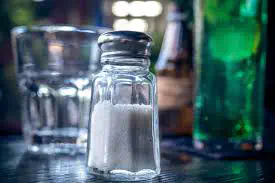Sex and Gender-based Analysis of this topic
Definition
Sodium chloride (NaCl) is predominantly consumed as table salt that is present in processed food or added during food preparation [1]. Only a small portion of sodium is consumed from adding salt to foods during mealtimes [2]. Many people who report eating foods high in sodium also report adding extra salt to their food [2]. Although a small amount of sodium is required for cellular metabolism, many Canadians exceed recommended daily sodium intake levels. Specifically, most women and girls are consuming 75% more than the recommended upper sodium intake levels [2].
Sex Issues
The diets of Canadian women mirror those of many other high-income countries: a calorie-rich diet that is deficient in essential nutrients [3]. Excessive salt is associated with hypertension and cardiovascular diseases [4-7]; osteoporosis [8-10]; kidney stones and kidney disease [6, 10]; stomach cancer [10], and severe asthma [4, 11]. Additionally, Canadians do not get enough potassium (found in fruits, vegetables, dairy products), which works in tandem with sodium to regulate metabolism and fluids [12], which may be implicated in hypertension.
Gender Issues
According to data from the 2009-2010 Canadian Community Health Survey (CCHS), 60% of women reported that knowledge of salt content influences their food choices [13]. Women’s food choices may subsequently affect the food their families consume given that women are often responsible for planning, purchasing, and preparing food for their families [14]. Using less healthy pre-packaged foods for meal preparation may be a convenient, less expensive option for many women.
Diversity
The amount of sodium contained in women’s diet increases with age, particularly during the teen years and at age 40 and older [13]. In a detailed analysis of data from the 2004 CCHS, adults (between the ages of 50 and 69) diagnosed with hypertension had higher salt intake compared to matched age controls without hypertension [15]. For Inuit women, traditional diets (when available and feasible) provide women with more protein and protein-related micronutrients and a lower intake of saturated fats, carbohydrates, and sodium [16].
Equity
“Food deserts” (city areas with few or no grocery stores) may be problematic for low income women who lack regular access to stores where fresh groceries are readily available [17]. Fast food restaurants and/or small expensive local grocers may be the only local option for these women, resulting in them frequenting convenient and less expensive places to shop, with fewer healthy food choices available. Urban women, who have access to large grocery shops with fresh produce, may have more healthy food choices when it comes to reduced salt content.
Critique
Adequately measuring sodium consumption is difficult given that many pre-packaged foods contain varying levels of sodium. The 2004 CCHS, which focused on nutrition, asked individuals about their efforts to reduce salt intake, but did not measure whether or not people add salt to their food while cooking or at the table. Nationally representative research is required to further examine Canadians’ sodium consumption behaviours. There are many reasons why it is not possible for individual women to consistently make healthy food choices. Additional research on these food choices could be used to create female-specific messaging and healthy eating education programs regarding sodium consumption.
